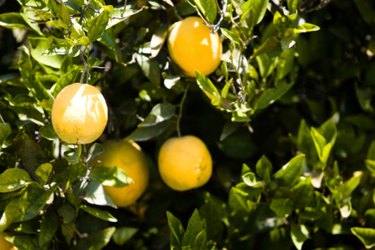Things You'll Need
Lopping shears
Tree wrap
Duct tape (optional)
Pest control sticky glue
Stick

Ants may be attracted to the fruit on your trees. Actually, they are likely attracted to the honeydew extractions that aphids, mealybugs, scales, whiteflies or other plant-sucking insects leave behind. These insects may be causing the most trouble for your fruit trees, and the ants are compounding the problem by scaring away the natural enemies of these other pests. Therefore, if you keep ants off your fruit trees, it helps you control the aphids and other plant-damaging insects.
Step 1
Clean up the debris and dropped fruit underneath your trees. This is a good practice that keeps all kinds of pests away, not just ants.
Video of the Day
Step 2
Prune away branches so that they are at least 12 to 30 inches above the ground. Use sharp, clean lopping shears.
Step 3
Wind Teflon or fabric tree wrap around the tree trunk, about 2 to 3 feet from the ground. It should be snug around the tree so that ants cannot go under it. Some wraps are actually tapes, but if yours is not secure it with duct tape. The wrap should be about 12 to 18 inches wide. Look at your local nursery or online for these products.
Step 4
Smear a sticky material, such as Tanglefoot or Stik-Em, on top of the center of the wrap all around the tree. The sticky material should be about 8 to 10 inches wide. Such glues are usually available where pest control products are sold. Use a stick or another utensil to smear it on. A paint stick works well. If you get some on your hands, wash it off with soap and water.
Step 5
Reapply the sticky material when it loses its stickiness, usually within two to 10 months. The higher up the trunk you initially install the wrap and glue, the longer it lasts because it is less exposed to water and dirt, which reduce its effectiveness.
Video of the Day